
Robert Rogerson was an early American industrialist. He was born in Taunton, Massachusetts, and died in the United States.

Robert Rogerson was an early American industrialist. He was born in Taunton, Massachusetts, and died in the United States.
Robert Rogerson was born in Taunton to parents who immigrated to the US from the UK. After leaving Taunton, he came to Uxbridge, Massachusetts, where he acquired the Clapp Mill in 1817, which had been established on the Mumford River about seven years earlier. This was the oldest cotton mill in Uxbridge. Rogerson then built two cotton mills at the Mumford River in Uxbridge in 1825. The complex became known as the Crown and Eagle Mills. The name derived from a tribute to both of his parents original (the Crown) and his families adopted (the Eagle) homelands. As well as the mills themselves, Rogerson built a village, acclaimed as an architectural masterpiece, designed and constructed with devotion and extravagance. [1] [2] [3]
It is known that Rogerson's ownership of the Crown and Eagle ended around 1837. The business had failed, partly due to the expense he had lavished on construction, and was acquired by James Whitin and the Whitin Family, who continued to operate the mill as the Uxbridge Cotton Mills. [4]
The Crown and Eagle Mills were burned around 1975. They have been restored and converted into Senior Housing. Rogersons Village, built by Robert Rogerson, is now part of the Blackstone River Valley National Heritage Corridor and is on the National Register of Historic Places.
Rogerson's wife may have been Ann Rogerson, who is listed in the Douglas Vital Records as wife of Robert Rogerson, having died in Douglas, Massachusetts. His daughter, Elizabeth Slater Rogerson, died in Uxbridge at age 18 on January 19, 1842.
He was also a scholar, a musician and for many years, the president of Boston's Handel and Haydn Society. [2] Rogerson did not die in Uxbridge, at least prior to 1850, but apparently lived there until at least the early 1840s.
{{cite web}}: CS1 maint: unfit URL (link)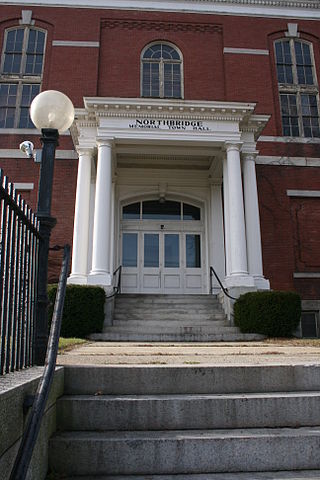
Northbridge is a town in Worcester County, Massachusetts, United States. The population was 16,335 at the 2020 census. The Northbridge Town Hall is located at 7 Main Street in Whitinsville. The town is now a part of the Blackstone River Valley National Heritage Corridor, of the National Park Service. Northbridge claims to history include: Native American Nipmuc lands, Colonel John Spring, who led the Uxbridge militia training company in the American Revolution, Samuel Spring, Revolutionary War Chaplain, the Residence of Ezra T. Benson 1830–1832, the birthplace of President Millard Fillmore's mother, Phoebe, and home to the Whitin Machine Works from 1831 to 1964.

Uxbridge is a town in Worcester County, Massachusetts, United States, first colonized in 1662 and incorporated in 1727. It was originally part of the town of Mendon, and named for the Earl of Uxbridge. The town is located 36 mi (58 km) southwest of Boston and 15 mi (24 km) south-southeast of Worcester, at the midpoint of the Blackstone Valley National Historic Park. The historical society notes that Uxbridge is the "Heart of The Blackstone Valley" and is also known as "the Cradle of the Industrial Revolution". Uxbridge was a prominent Textile center in the American Industrial Revolution. Two Quakers served as national leaders in the American anti-slavery movement. Uxbridge "weaves a tapestry of early America".

Whitinsville is an unincorporated village within the town of Northbridge in Worcester County, Massachusetts, United States. Whitinsville is a census-designated place (CDP) and its population was 6,750 at the 2020 census. Whitinsville is pronounced as if it were spelled "White-ins-ville". It was founded by the Whitin family, after whom it is also named. It is a post office jurisdiction, with a ZIP Code of 01588. It is located on the Mumford River, a tributary of the Blackstone River.
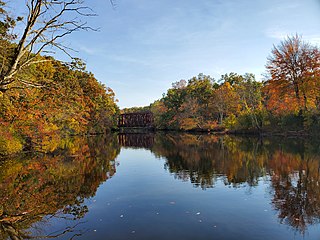
The Blackstone River is a river in the United States that flows through the states of Massachusetts and Rhode Island. It is 48 mi (77 km) long with a drainage area of 540 sq mi (1,400 km2) and drains into the Seekonk tidal river at Pawtucket, Rhode Island. Its long history of industrial use has caused significant pollution, with the United States Environmental Protection Agency describing it as “the most polluted river in the country because of high concentrations of toxic sediments.”

The Blackstone Valley or Blackstone River Valley is a region of Massachusetts and Rhode Island. It was a major factor in the American Industrial Revolution. It makes up part of the Blackstone River Valley National Heritage Corridor and National Historical Park.
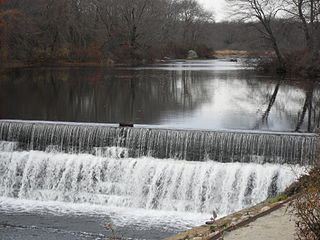
The Mumford River is an 18.3-mile-long (29.5 km) river in south-central Massachusetts. It is a tributary of the Blackstone River.

Daniel Day was an American pioneer in woolen manufacturing.
Luke Taft was an industrial pioneer in the manufacture of woolens in 19th century New England.

Moses Taft 2nd was born at Uxbridge, Massachusetts. He was significant as an early American Industrialist and financier in the historic Blackstone Valley, and a member of the famous Taft family.
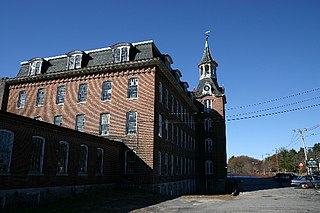
Linwood is a village with its own post office in the towns of Northbridge and Uxbridge, Massachusetts.
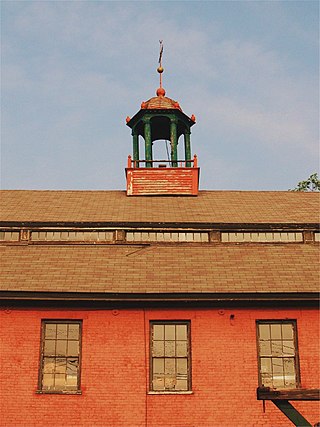
Col. Paul Whitin, (1767–1831) was an American blacksmith and pioneering industrialist who in 1826 Northbridge, Massachusetts established P Whitin and Sons, a new cotton mill with his sons. This company would grow and acquire other mills in the area. In 1831 his son John C Whitin obtained a patent for a mechanized Cotton Picker. Textile machinery would become a larger percentage of their business over time. would later become the largest maker of specialty textile machinery in the world.
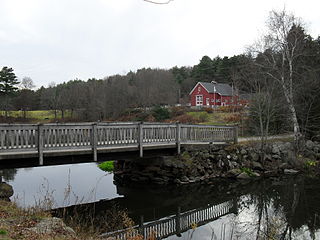
The Blackstone River and Canal Heritage State Park is a part of the state park system of the Commonwealth of Massachusetts, managed by the Massachusetts Department of Conservation and Recreation (DCR). This 1,000-acre (4.0 km2) park "recalls the role of canals in transporting raw materials and manufactured goods between emerging industrial centers." The Blackstone River and Canal Heritage State Park at Uxbridge, Massachusetts, is the midpoint of the Blackstone River Valley National Heritage Corridor of the National Park System. The Blackstone River and Valley is where the industrial revolution was born in America. The southern entrance to this state park is the site of the historic Stanley Woolen Mill, currently being redeveloped for commercial and tourism. The Native American Nipmuc name for the village here was "Wacentug", translated as "bend in the river".

North Uxbridge is a village and a post office in the town (township) of Uxbridge in Worcester County, Massachusetts, United States. The postal zip code is 01538. It is classified as a community or populated place located at latitude 42.088 and longitude -71.641 and the elevation is 266 feet (81 m). North Uxbridge appears on the Uxbridge U.S. Geological Survey Map. Worcester County is in the Eastern time zone and observes DST. North Uxbridge is located about 36 miles WSW of Boston, and 15 miles SE of Worcester. The town meeting in 1885 set aside North Uxbridge as a "special district", since its population had exceeded 1000 people. North Uxbridge appeared to be a separate Census tract in the 1960 census with a population of 1882. In 2013, an Uxbridge DIY show, The Garage, with Steve Butler, went worldwide from Steve's garage in North Uxbridge.

Wheelockville is a village in the town (township) of Uxbridge, Massachusetts, United States. Part of the village centering on Mendon and Henry streets is listed on the National Register of Historic Places as the Wheelockville Historic District. Wheelockville appears on the Blackstone U.S. Geological Survey Map. The Village receives municipal services from Uxbridge, for fire, police, EMS, School district, public works, and other services. Worcester's Judicial District includes Uxbridge District Court. The geography of Wheelockville includes several other distinct mill villages, including: Hecla and Elmdale.
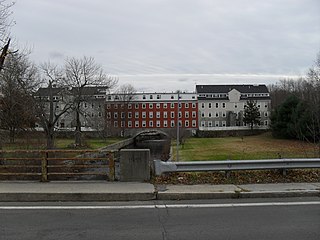
Rogersons Village Historic District is a historic mill village in Uxbridge, Massachusetts, United States.

The Whitin Machine Works (WMW) was founded by Paul Whitin and his sons in 1831 on the banks of the Mumford River in Northbridge, Massachusetts. The village in this section of Northbridge became known as Whitinsville in 1835, in honor of its founder.
The history of Uxbridge, Massachusetts, founded in 1727, may be divided into its prehistory, its colonial history and its modern industrial history. Uxbridge is located on the Massachusetts-Rhode Island state line, and became a center of the earliest industrialized region in the United States.

Stanley Woolen Mill is the common historic name applied to a defunct company based in southeastern Massachusetts and to the company's buildings which stand at the southern entrance to the Blackstone River and Canal Heritage State Park. The mill is an important footnote in the history of the textile industry in America. Stanley Woolen Mill is the centerpiece of the Central Woolen Mills District which is part of the National Historic Register.